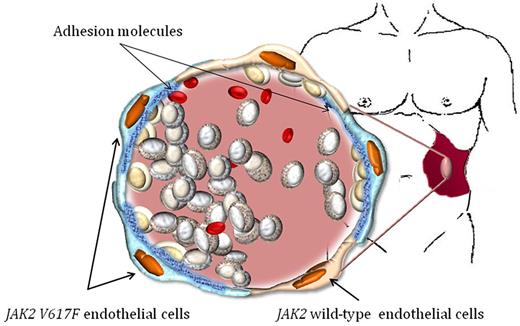In this issue of Blood, Rosti and colleagues report that in JAK2V617F positive patients with myelofibrosis (MF), a proportion of endothelial cells (ECs) from spleen tissues and splenic vein harbored this mutation.1
As might be expected, these findings reinforce the more expansive concept of tumor angiogenesis. Since the seminal studies by Folkman more than 40 years ago, cancer biology has demonstrated that tumors are not masses of autonomous aberrant cells, but rather organs in which different normal and neoplastic cells interact to produce their own tumor vasculature.2,3 In almost all types of solid tumors, 1 or more mechanisms responsible for tumor angiogenesis can be found—sprouting from normal capillaries, or through co-option or intussusceptions of pre-existing vessels, or by vasculogenic mimicry by tumor cells, or, finally, through new vessel formation by cancer stem cell.4 Whatever the mechanisms involved, the development of internal tumor circulation, despite evident morphologic and functional abnormalities, aims unequivocally to guarantee nutrient delivery and waste removal.4 As a consequence, the study by Rosti et al raises 2 obvious questions: (1) are the JAK2V617F positive endothelial cells the manifestation of genuine tumor angiogenesis, and (2) what are the effects of tumor-derived endothelial cells on the “myeloproliferative” environment?
In their study, Rosti et al tested for the presence of JAK2V617F mutation ECs isolated from spleen tissue of 11 patients with primary MF and 7 patients with postpolycythemia or postessential thrombocythemia MF. The authors obtained ECs by laser microdissection (LM) from fixed samples or by cell sorting in fresh samples. Fresh samples were also used to grow endothelial colony-forming cell (ECFC) or EC cultures. Furthermore, in 11 patients, splenic vein samples were evaluated. Overall, among 18 patients, 12 had the detection of at least 1 mutated EC in samples isolated by LM (5 patients), or in EC cultures (4 patients), or in both LM samples and EC cultures (3 patients). One patient had mutated ECs also in the splenic vein sample. Most patients had both wild-type and mutated ECs, suggesting variable combinations of normal and tumor ECs to vessel wall. The authors tried to exclude any potential source of contamination in tested samples: the multifaceted approach used to isolate the ECs and the extensive phenotypic characterization of mutated cells guarantees both the endothelial purity and the true endothelial nature of mutated ECs. Furthermore, ECs often harbored homozygous mutation, and no aneuploidy and/or tetraploidy cells were detected. Indeed, the possibility that ECs could have acquired exogenous DNA carrying the JAK2V617F mutation through cell fusion or phagocytosis was reasonably ruled out.1 Nevertheless, understanding how mutated ECs and hematopoietic cells interact in the splenic microenvironment is an even more intriguing issue. Environmental components are crucial regulators of normal and malignant stem cell behavior. In particular, within the bone marrow tissue a mosaic of microenvironments provides specified sets of instructions regulating or reinforcing cell fate. Recently, several observations have provided evidence that the vascular niche plays an important role in influencing hematopoietic stem cell (HSC) dormancy, self-renewal, and proliferation.5,6 Indeed, functional characterization of JAK2 mutated ECs should be attempted to understand whether tumor angiogenesis promotes splenic myeloproliferation. Our group recently reported that in some patients with Ph-negative chronic myeloproliferative neoplasms (MPNs), circulating ECFCs exhibit some neoplastic signatures such as JAK2V617F mutation, Suppressor of Cytokine Signaling (SOCS) gene hypermethylation, or clonal derivation.7 Importantly, these cells had an exaggerated adhesive affinity toward mononuclear cells7 and shared an increased expression of m-RNA for various adhesive molecules such as ICAM-1, VCAM1, and E-selectin (L.T. and L.M.L., unpublished data, February 8, 2012). In this regard, it was recently reported that the E-selectin expressed by bone marrow endothelial cells within the vascular niche promotes HSC proliferation at the expense of self-renewal.8
Overall, data emerging from the study by Rosti and colleagues, together with others, converge toward the attractive assumption that the hemangioblast would be the putative MPN stem cell. Therefore, hemangioblasts should originate both myeloid and endothelial neoplastic progeny.
Within this unique tumor model, endothelial cells could serve as a niche component for the hematopoietic cell counterpart, supporting its survival and proliferation (see figure). In this perspective, when considering therapeutic options for MPN patients, we should remember that in the MPN context myeloproliferation and angiogenesis are tightly connected.
In myelofibrosis, both angiogenesis and myeloproliferation constitute the expression of neoplastic growth. A significant proportion of endothelial cells lining the spleen microvasculature harbors the JAK2V617F mutation. The figure illustrates how mutated endothelial cells, producing abnormally high levels of adhesion molecules such as ICAM-1, V-CAM, and E-selectin, might represent the “neoplastic” vascular niches where trapped hematopoietic stem cells are forced to proliferate. Indeed, in spleen microenvironment, neoplastic myeloproliferation and angiogenesis are tightly interrelated.
In myelofibrosis, both angiogenesis and myeloproliferation constitute the expression of neoplastic growth. A significant proportion of endothelial cells lining the spleen microvasculature harbors the JAK2V617F mutation. The figure illustrates how mutated endothelial cells, producing abnormally high levels of adhesion molecules such as ICAM-1, V-CAM, and E-selectin, might represent the “neoplastic” vascular niches where trapped hematopoietic stem cells are forced to proliferate. Indeed, in spleen microenvironment, neoplastic myeloproliferation and angiogenesis are tightly interrelated.
Conflict-of-interest disclosure: The authors declare no competing financial interests. ■


This feature is available to Subscribers Only
Sign In or Create an Account Close Modal